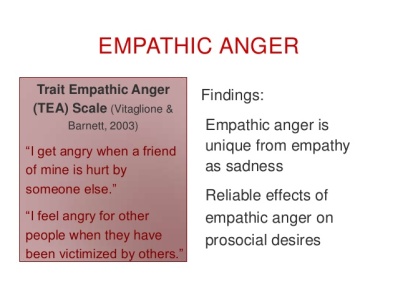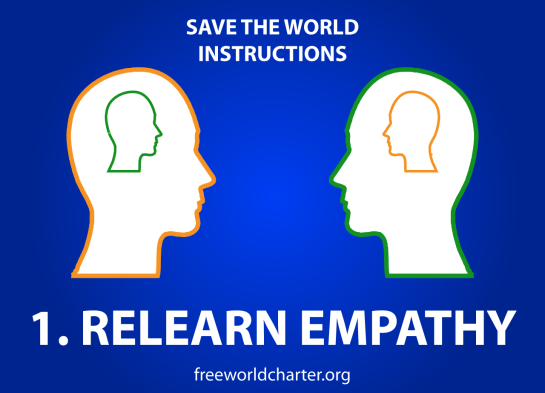«[…] Empathy, which I define as an affective response more appropriate to someone else’s situation than to one’s own. […]»
Puka, B. (Ed.). (1994). Moral Development: Reaching out (Vol. 7). Taylor & Francis.
Hablemos de aquello que a tanto gusta a la sociedad: la empatía. Al fin y al cabo… somos seres empáticos, ¿verdad? ERROR: tenemos la capacidad de ser empáticos, ¿pero será cierto que todos empleamos bien esa capacidad?
A los humanos se les hincha el pecho y llena la boca alardeando de lo EMPÁTICOS que son, y de lo ética que es la humanidad, en base a una moral profunda y correcta, fomentada precisamente por esa empatía que «TODOS tenemos».
Me reiría, pero intento darle un toque de seriedad a esta entrada, así que sigamos. Muy poca gente es empática, por lo tanto esa ética con base moral que tanto llena la boca a la sociedad es mayormente un rasgo aprendido y no autocuestionado, por lo tanto no sustentado por una gran empatía propia. No es de extrañarse, pues, que un individuo la aplique en su día a día, en general, pero no lo haga cuando realmente su valor y necesidad son críticas. En ese momento, primarán para el individuo otras características que SÍ poseerá, mas no la empatía. (Y no me refiero a sucesos de supervivencia).
Empathy is the capacity to understand what another person is experiencing from within the other person’s frame of reference, ie, the capacity to place oneself in another’s shoes. Empathy has many different definitions that encompass a broad range of emotional states, including caring for other people and having a desire to help them; experiencing emotions that match another person’s emotions; discerning what another person is thinking or feeling; and making less distinct the differences between the self and the other. It also is the ability to feel and share another person’s emotions. Some believe that empathy involves the ability to match another’s emotions, while others believe that empathy involves being tenderhearted toward another person. Compassion and sympathy are two terms that many associate with empathy, but all three of these terms are unique. Compassion is an emotion we feel when others are in need, which motivates us to help them. Sympathy is a feeling of care and understanding for someone in need.
Un artículo que parece interesante, aunque por desgracia hay que comprarlo ^^U Y no money, no party. Pero lo dejo por si alguien puede y quiere… http://www.sciencedirect.com/science/article/pii/S0149763406000522
Social neuro-science has recently started to investigate the neuronal mechanisms underlying our ability to understand the mental and emotional states of others. In this review, imaging research conducted on theory of mind (ToM or mentalizing) and empathy is selectively reviewed.
Empathy has also been compared with altruism and egotism. Altruism is behavior that is aimed at benefitting another person, while egotism is a behavior that is acted out for personal gain. Sometimes, when someone is feeling empathetic towards another, acts of altruism occur. However, many question whether or not these acts of altruism are motivated by egotistical gains. According to positive psychologists, people can be adequately moved by their empathies to be altruistic.
Otro artículo de similares características -_- http://www.annualreviews.org/doi/abs/10.1146/annurev.psych.59.103006.093625
Empathy is an ideal candidate mechanism to underlie so-called directed altruism, i.e., altruism in response to anothers’s pain, need, or distress. Evidence is accumulating that this mechanism is phylogenetically ancient, probably as old as mammals and birds.
Afective and cognitive empathy:
- Affective empathy, also called emotional empathy: the capacity to respond with an appropriate emotion to another’s mental states. Affective empathy can be subdivided into the following scales:
- Empathic concern: sympathy and compassion for others in response to their suffering
- Personal distress: self-centered feelings of discomfort and anxiety in response to another’s suffering. There is no consensus regarding whether personal distress is a basic form of empathy or instead does not constitute empathy.There may be a developmental aspect to this subdivision. Infants respond to the distress of others by getting distressed themselves; only when they are 2 years old do they start to respond in other-oriented ways, trying to help, comfort and share.
- Cognitive empathy: the capacity to understand another’s perspective or mental state. Cognitive empathy can be subdivided into the following scales:
- Perspective taking: the tendency to spontaneously adopt others’ psychological perspectives.
- Fantasy: the tendency to identify with fictional characters.
A difference in distribution between affective and cognitive empathy has been observed in various conditions.Psychopathy, schizophrenia and narcissism have been associated with impairments in affective but not cognitive empathy, whereas bipolar disorder and borderline traits have been associated with deficits in cognitive but not affective empathy. Autism spectrum disorders have been associated with various combinations, including deficits in cognitive empathy as well as deficits in both cognitive and affective empathy.
The opposite of empathy is a complete lack of regard for another’s feelings or well-being, something like bullying.
- Individual differences: In essence, not every individual responds equally and uniformly the same to various circumstances. The Empathic Concern scale assesses “other-oriented” feelings of sympathy and concern and the Personal Distress scale measures “self-oriented” feelings of personal anxiety and unease. The combination of these scales helps reveal those that might not be classified as empathetic and expands the narrow definition of empathy. Using this approach we can enlarge the basis of what it means to possess empathetic qualities and create a multi-faceted definition.
- Es difícil medir las diferencias entre individuos, pero se realizan estudios con este fin:
- file:///C:/Users/Ribosoma/Downloads/0046352dee2296ea54000000.pdf
- http://ajp.psychiatryonline.org/doi/10.1176/appi.ajp.159.9.1563
Empathy is easily noted and recognized in humans. However, new research has shown that the ability of empathy in other species is indeed attainable. Many instances of empathy have been recorded throughout many species, including but not limited to canines, felines, dolphins, primates, rats and mice. In animals, empathy-related responding could in fact have an ulterior motive such as survival, the sharing of food, companionship and pack-oriented mentality. It is certainly difficult to understand an animal’s intention behind an empathic response. Many researchers maintain that applying the term empathy in general to animal behavior is an act of anthropomorphism.
Empathic distress is feeling the perceived pain of another person. This feeling can be transformed into empathic anger, feelings of injustice, or guilt. These emotions can be perceived as pro-social, and some say they can be seen as motives for moral behavior.
- Empathic anger is an emotion, a form of empathic distress. Empathic anger is felt in a situation where someone else is being hurt by another person or thing. It is possible to see this form of anger as a pro-social emotion. Empathic anger has direct effects on both helping and punishing desires. Empathic anger can be divided into two sub-categories: trait empathic anger and state empathic anger.
Psychopathy (profundizando) is a personality disorder partly characterized by antisocial and aggressive behaviors, as well as emotional and interpersonal deficits including shallow emotions and a lack of remorse and empathy. A large body of research suggests that psychopathy is associated with atypical responses to distress cues (e.g. facial and vocal expressions of fear and sadness), including decreased activation of the fusiform and extrastriate cortical regions, which may partly account for impaired recognition of and reduced autonomic responsiveness to expressions of fear, and impairments of empathy. Studies on children with psychopathic tendencies have also shown such associations. The underlying biological surfaces for processing expressions of happiness are functionally intact in psychopaths, although less responsive than those of controls. The neuroimaging literature is unclear as to whether deficits are specific to particular emotions such as fear. Some recent fMRI studies have reported that emotion perception deficits in psychopathy are pervasive across emotions (positives and negatives).
A recent study on psychopaths found that under certain circumstances, they could willfully empathize with others, and that their empathic reaction initiated the same way it does for controls. Psychopathic criminals were brain-scanned while watching videos of a person harming another individual. The psychopaths’ empathic reaction initiated the same way it did for controls when they were instructed to empathize with the harmed individual, and the area of the brain relating to pain was activated when the psychopaths were asked to imagine how the harmed individual felt. The research suggests how psychopaths could switch empathy on at will, which would enable them to be both callous and charming. The team who conducted the study say it is still unknown how to transform this willful empathy into the spontaneous empathy most people have, though they propose it could be possible to bring psychopaths closer to rehabilitation by helping them to activate their «empathy switch». Others suggested that despite the results of the study, it remained unclear whether psychopaths’ experience of empathy was the same as that of controls.
 Work conducted by Professor Jean Decety with large samples of incarcerated psychopaths offers additional insights. In one study, psychopaths were scanned while viewing video clips depicting people being intentionally hurt. They were also tested on their responses to seeing short videos of facial expressions of pain. The participants in the high-psychopathy group exhibited significantly less activation in the ventromedial prefrontal cortex, amygdala andperiaqueductal gray parts of the brain, but more activity in the striatum and the insula when compared to control participants. In a second study, individuals with psychopathy exhibited a strong response in pain-affective brain regions when taking an imagine-self perspective, but failed to recruit the neural circuits that were activated in controls during an imagine-other perspective—in particular the ventromedial prefrontal cortex and amygdala—which may contribute to their lack of empathic concern.
Work conducted by Professor Jean Decety with large samples of incarcerated psychopaths offers additional insights. In one study, psychopaths were scanned while viewing video clips depicting people being intentionally hurt. They were also tested on their responses to seeing short videos of facial expressions of pain. The participants in the high-psychopathy group exhibited significantly less activation in the ventromedial prefrontal cortex, amygdala andperiaqueductal gray parts of the brain, but more activity in the striatum and the insula when compared to control participants. In a second study, individuals with psychopathy exhibited a strong response in pain-affective brain regions when taking an imagine-self perspective, but failed to recruit the neural circuits that were activated in controls during an imagine-other perspective—in particular the ventromedial prefrontal cortex and amygdala—which may contribute to their lack of empathic concern.
Psychopaths may have a different baseline when it comes to empathy. Professor Simon Baron-Cohen suggests that, unlike the combination of both reduced cognitive and affective empathy often seen in those with classic autism, psychopaths are associated with intact cognitive empathy, implying non-diminished awareness of another’s feelings when they hurt someone.
¡Y fin! Espero que al menos os haya resultado interesante… y que ahora comprendáis mejor mi sufrimiento. La sociedad me abruma, y no por nada.
~Eve (Ribosoma)








